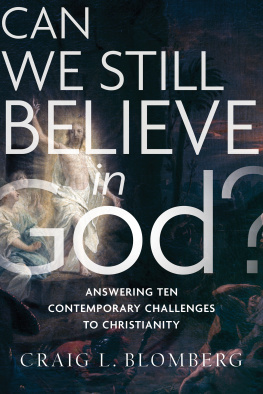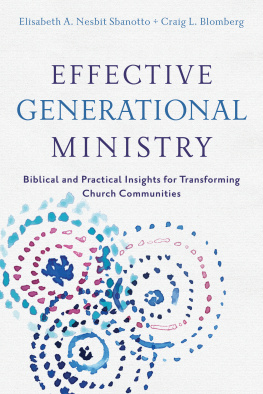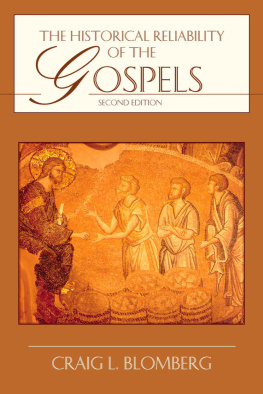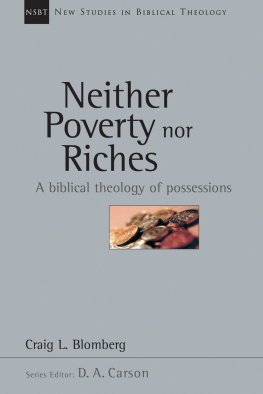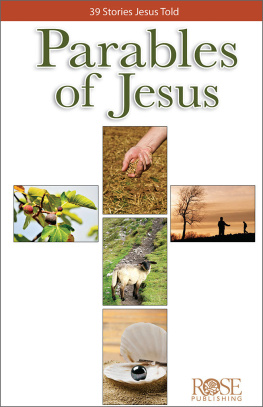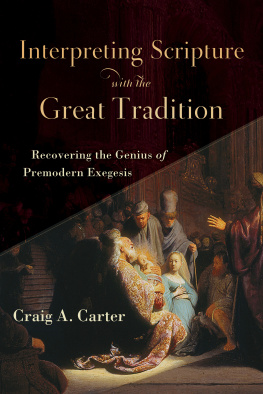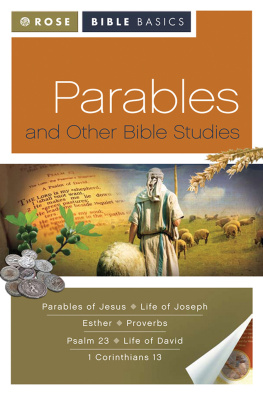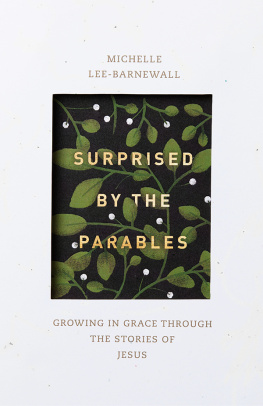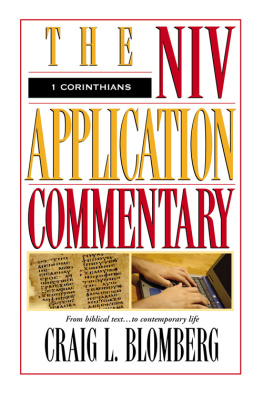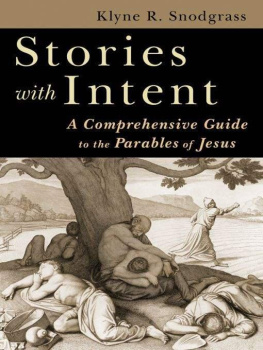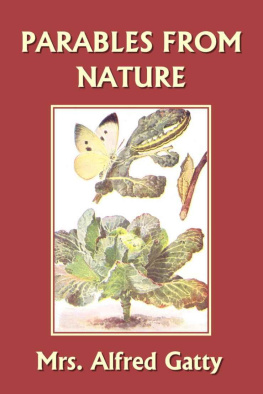Craig L. Blomberg - Interpreting the Parables
Here you can read online Craig L. Blomberg - Interpreting the Parables full text of the book (entire story) in english for free. Download pdf and epub, get meaning, cover and reviews about this ebook. year: 2012, publisher: InterVarsity Press / IVP Academic, genre: Religion. Description of the work, (preface) as well as reviews are available. Best literature library LitArk.com created for fans of good reading and offers a wide selection of genres:
Romance novel
Science fiction
Adventure
Detective
Science
History
Home and family
Prose
Art
Politics
Computer
Non-fiction
Religion
Business
Children
Humor
Choose a favorite category and find really read worthwhile books. Enjoy immersion in the world of imagination, feel the emotions of the characters or learn something new for yourself, make an fascinating discovery.

- Book:Interpreting the Parables
- Author:
- Publisher:InterVarsity Press / IVP Academic
- Genre:
- Year:2012
- Rating:5 / 5
- Favourites:Add to favourites
- Your mark:
- 100
- 1
- 2
- 3
- 4
- 5
Interpreting the Parables: summary, description and annotation
We offer to read an annotation, description, summary or preface (depends on what the author of the book "Interpreting the Parables" wrote himself). If you haven't found the necessary information about the book — write in the comments, we will try to find it.
Interpreting the Parables — read online for free the complete book (whole text) full work
Below is the text of the book, divided by pages. System saving the place of the last page read, allows you to conveniently read the book "Interpreting the Parables" online for free, without having to search again every time where you left off. Put a bookmark, and you can go to the page where you finished reading at any time.
Font size:
Interval:
Bookmark:

Introduction

B ooks about the parables of Jesus come in many kinds. Some reflect popular exposition and preaching, others are used as textbooks in college or seminary courses, and still others represent scholarly studies written primarily for other scholars. In the last century, more studies of the parables were So any new book like this one ought to justify its existence in some detail. There are at least two main reasons for this book. The first may be explained quite simply; the second will require elaboration.
The simpler reason is that whenever an area of research generates as many studies as the parables have, a majority of Bible readers is unlikely ever to know of most of them, much less understand their contributions and significance. Of the three categories of books on parables just itemized, the least well-stocked are works that can serve well as textbooks. Two outstanding volumes of the past decade are comprehensive enough to cover most everything that ought to be discussed, but one of these is probably too advanced for most This volume, therefore, brings a state-of-the-art report on parable scholarship in a form intended to be useful as an update for pastors and scholars, a basic textbook for students in colleges and seminaries, and an introduction to the field for the layperson willing to wrestle in some detail with scholarly concerns.
This book, however, also defends a thesis. This is the second reason for its publication: there are good reasons to believe that in important ways the dominant approaches of the twentieth century to the interpretation of the parables were misguided and require rethinking. This is a bold claim but one echoed in an ever-growing number of parable studies. Some similarities exist among the alternatives put forward in these studies, but there is scarcely any consensus. The academic guild of biblical scholars, moreover, has become so large and diverse that it is completely possible, and in some peoples minds acceptable, to write simply for one theological or ideological tradition and remain blithely unaware of other major swaths of academia. Or at least various works continue to appear that betray no such So this book hopes to make a fresh contribution to the interpretation of the parables as well as to survey the contemporary scholarly scene.
How did the majority of scholars approach
1. Throughout the history of the church, most Christians interpreted the parables as allegories. That is, interpreters assumed that many of the individual characters or objects in the parables stood for something other than themselvesspiritual counterparts which enabled the story to be read at two levels. A parable was not just a story about human activity but also a narrative of heavenly reality.
To take perhaps the most famous parable of all as an example, the story of the prodigal son (Lk 15:11-32) was viewed not simply as a poignant drama of a Jewish fathers remarkable forgiveness for his wayward son. Rather it was assumed that a series of one-to-one correspondences could be set up so that the father stood for God, the prodigal for any sinner running away from God and the older brother for the hardhearted Pharisee. Usually the number of correspondences was extended. The ring the father gave the prodigal might represent Christian One by one, most all of the details were explained, and the spiritual significance of the story was determined.
2. Modern scholarship has rightly rejected allegorical interpretation, instead favoring an approach that allows for each parable to make only one main point. Down through the centuries, the artificial and arbitrary nature of the elaborate type of allegorization illustrated above became progressively clearer. A careful comparison of older expositors shows that they often did not agree on what each of the details in a given parable represented. To return to the example of the prodigals robe, in addition to immortality it was interpreted as standing for sinlessness, the Holy Spirit, baptism, wisdom, love, spiritual
Supporters of these different interpretations all recognized that the father gave the robe to the prodigal to indicate his restoration to the family. But it was impossible to agree on how to match that robe with one particular aspect of a new Christians relationship with his or her heavenly Father. Presumably the lesson to be learned is that the robe is not meant to be allegorized. In fact even to view the father as directly standing for God is often held to be inappropriate. After all, God himself seems to be referred to in the parable as a separate character, however indirectly, when the prodigal speaks of sinning against his father and against heaven (Lk 15:18, 21). So instead of allegorizing individual details, one must seek to encapsulate the storys message
3. Nevertheless, the parables as they appear in the Gospels do have a few undeniably allegorical elements, but these are the exception and not the rule. One frequently
The problem with all that has been summarized so far comes to a head most clearly when one examines the only two parables for which Jesus himself supplied a detailed interpretationthe sower (Mk 4:3-9, 13-20 pars.) and the wheat and tares (Mt 13:24-30, 36-43). In each of these interpretations, almost all the major details of the parables are explained by means of a series of one-to-one correspondences. The seed is the Word of God, the four soils are four kinds of people, the birds represent Satan, the thorns stand for the cares of this life, and so on. Yet this looks precisely like the allegorical approach of the premodern era that was so roundly rejected!
4. Thus the occasional explicit interpretations of parables in the Gospels are additional exceptions to Jesus usual practice, and they too are not to be taken as normative. At this point all but the most conservative commentators agree that the interpretations for these two parables are simply not authentic. They were supplied by the early church or perhaps even the Gospel writers themselves. The true meaning of a parable like that of the sower is to be found in a general principle such as this: In spite of every failure and opposition, from The very fact that Jesus left most of his parables without such interpretation proves that they are to be taken less elaborately.
5. Apart from this small amount of allegory, most of the parables and most parts of each parable are among the most indisputably authentic sayings of Jesus in the Gospels. Most Gospel critics regularly differentiate between sayings ascribed to Jesus that they can with a fair degree of probability accept as genuinely his and those they believe came from a later source. The most prominent criteria used to make such distinctions include dissimilarity (that which marks Jesus off as different from both the Judaism of his day and from the early church could have come from no one else), multiple attestation (that which occurs in several Gospels or in several different Gospel sources is more likely authentic than that which is singly attested) and coherence (that which
The authentic core of the Gospels lies in Jesus teaching about the kingdom of God entering history by
There are a few features of the parables that are usually attributed to later stages of tradition. But these can generally be identified by discerning the laws of transformation which the oral tradition of Jesus sayings underwent prior to the writing of the Gospels, or by observing patterns of redactionthe ways in which the Gospel writers themselves shaped the material they inherited. The disciplines of form criticism and redaction criticism have grown up among students of the Gospels primarily to detect these kinds of changes on a more widespread basis, so that it is not too difficult to apply their insights in the particular case of the parables.
Font size:
Interval:
Bookmark:
Similar books «Interpreting the Parables»
Look at similar books to Interpreting the Parables. We have selected literature similar in name and meaning in the hope of providing readers with more options to find new, interesting, not yet read works.
Discussion, reviews of the book Interpreting the Parables and just readers' own opinions. Leave your comments, write what you think about the work, its meaning or the main characters. Specify what exactly you liked and what you didn't like, and why you think so.

